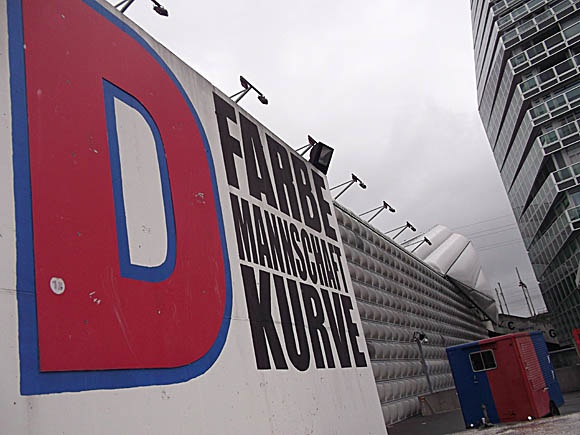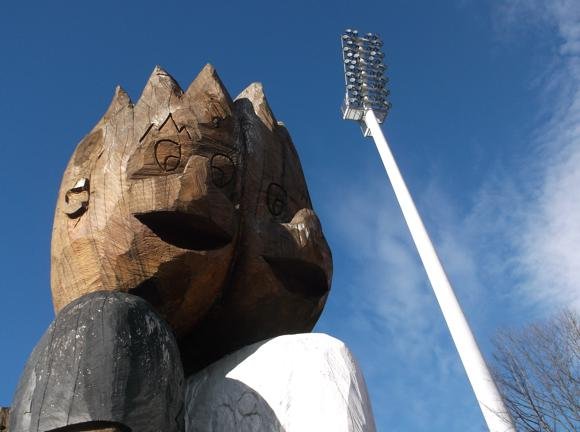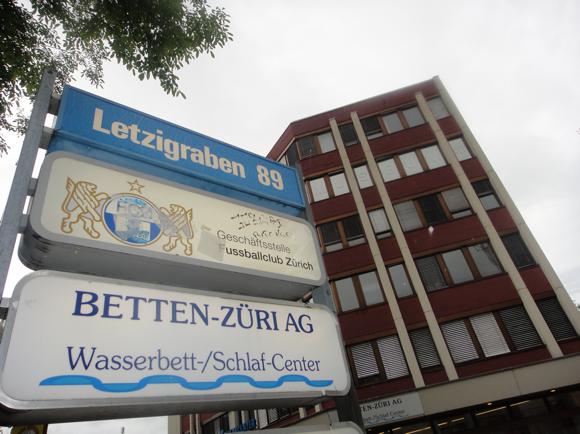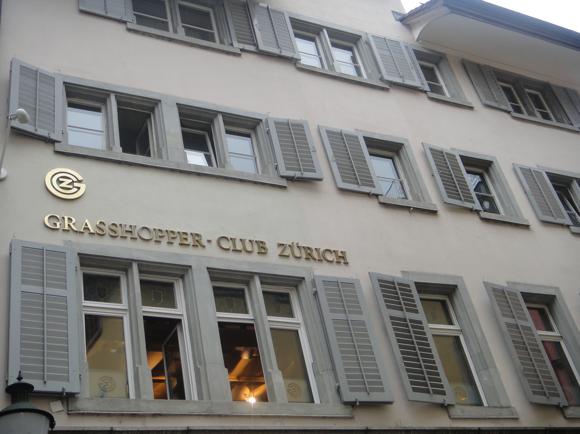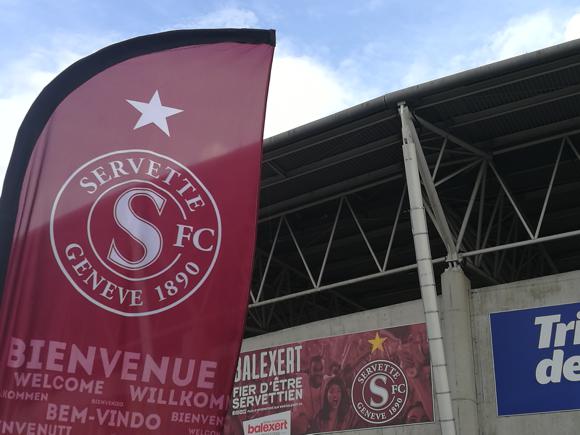A fan’s guide – the club from early doors to today
A familiar if unusual name from European competitions in the 1980s and 1990s, Neuchâtel Xamax must be the only case of a top-tier club being founded by a ten-year-old boy.
That club, FC Xamax, later fused with Neuchâtel-Sports, known for six decades as FC Cantonal, to create Neuchâtel Xamax in 1970.
And that youngster was Max ‘Xam’ Abegglen, one of three brothers who would later earn more than 100 caps for Switzerland between them.
Born, like André ‘Trello’ and Jean, in Neuchâtel, Xam Abegglen formed Xamax with his boyhood mates in 1912. The team played its first match in 1916, which was when another local side, FC Cantonal, won their only Swiss title.

Cantonal built the Stade de la Maladière in 1924, the same year that goals from Xam Abegglen enabled Switzerland to reach the final of the Olympic Games football tournament, the then equivalent of the World Cup. André’s international career came later, and his three-minute brace helped defeat Nazi Germany in the biggest shock of the 1938 World Cup.
Both had short stints at Cantonal, by then long overshadowed by the likes of Servette and Grasshoppers, where they starred. Cantonal made and lost the replayed Swiss Cup final of 1950 then faded. By 1966, they finished rock bottom of the second tier, passing FC Xamax, who had reversed decades of underachievement by gaining promotion from the Third.
Using the Stade de la Maladière as its base, in 1970, a new club was formed from the merger of FC Xamax and FC Cantonal, by then briefly renamed Neuchâtel-Sports. Overseen by Sepp Blatter, making his way in the murky world of football administration, Neuchâtel Xamax continued to knock on the door of the top-tier Ligue nationale A until promotion in 1973.

Soon a Strasbourg legend arrived to see out his playing career in Switzerland. Gilbert ‘Giless’ Gress had two seasons as player-manager before returning to Alsace to take Strasbourg to their only league title, in 1979.
Two years later, he was lured back to Neuchâtel, where he presided over the most successful decade in the club’s 50-year history. Persuading former QPR star and Irish international Don Givens to leave the UK, Gress first led Xamax to the quarter-finals of the UEFA Cup, past Sparta Prague, Malmö and Sporting Lisbon before a 3-2 defeat to Franz Beckenbauer’s Hamburg.
Givens would go on to appear nearly 150 times for Xamax, playing until his late thirties, bowing out after the title-winning season of 1986-87. Having beaten Dundee United and Real Madrid in the home legs of the previous UEFA Cup, a surprise early exit a year later allowed Xamax to concentrate on the league.
With 1982 German World Cup star Uli Stielike pulling the strings, and record Swiss cap Heinz Hermann alongside him, the Neuchâtel side romped to a first Swiss championship, five points ahead of Grasshoppers. Top scorer Beat Sutter helped Xamax outdistance their Zürich rivals.

Six months later, Xamax came within three minutes of a famous victory over Bayern Munich, two very late goals at the Olympiastadion reversing the 2-1 Swiss win at the Stade de la Maladière. With Givens bowing out, Sutter again proved vital in Xamax retaining the league title in 1988.
Gress was then snapped up by Servette, returning to Neuchâtel in the mid-1990s, seeing another title slip from his grasp in the desperately close title run-in of 1996-97.
Xamax continued to create the odd surprise in Europe, four goals from Egyptian World Cup star Hossam Hassan featuring in the 5-1 thumping of Celtic in 1991, twin brother Ibrahim the only name on the scoresheet when Neuchâtel defeated Real Madrid 1-0 at home in the next round. It was only in 1997, 16 years and 26 games, that Xamax succumbed to European opposition at the Maladière, a 2-0 loss to a Ronaldo-led Inter.
Discounting the short, forgettable UEFA Cup campaign of 2003-04, the Inter tie would represent Neuchâtel’s last major foray in Europe. With unfortunate timing, demolition of the old Stade de la Maladière preceded a first-ever relegation in 2006.
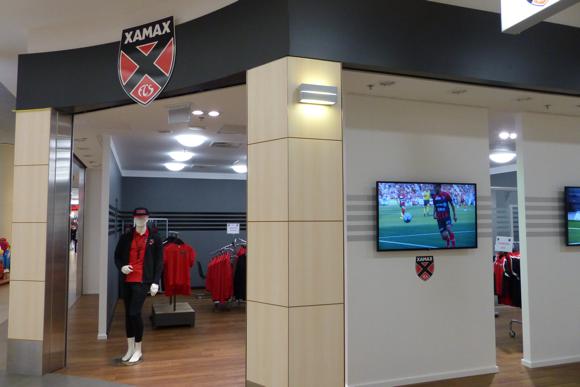
Opened during the successful campaign to bounce back at the first time of asking, the new stadium witnessed four mediocre seasons in the Super League before a fifth was halted in extraordinary circumstances halfway through 2011-12. The club had changed owners, Chechen entrepreneur Bulat Chagayev taking over and making former Spartak Moscow striker Andrei Rudakov president. Chagayev was then charged with forgery and jailed for improper management. Neuchâtel Xamax were duly declared bankrupt.
With the efforts of the City, the Region and various interested parties, the club was resurrected and a side of mainly under 21s joined the fifth tier, the 2e Ligue interrégionale.
Promotion in 2013 coincided with a merger with local side FC Serrières. The squad strengthened, Xamax won another two consecutive promotions to join the second-tier Challenge League in 2015.
With goals from Raphaël Nuzzolo, a Xamax regular through the early 2000s, the club finished runners-up in 2016 and 2017, then won the division by a country mile in 2018. Continuing to score at top level, Nuzzolo could do little about Neuchâtel’s porous defence as Xamax marked their return to the Super League with two wins the entire autumn campaign.
Stadium Guide
The field of dreams – and the stands around it
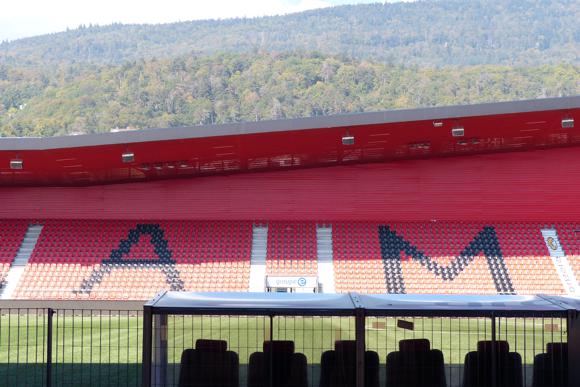

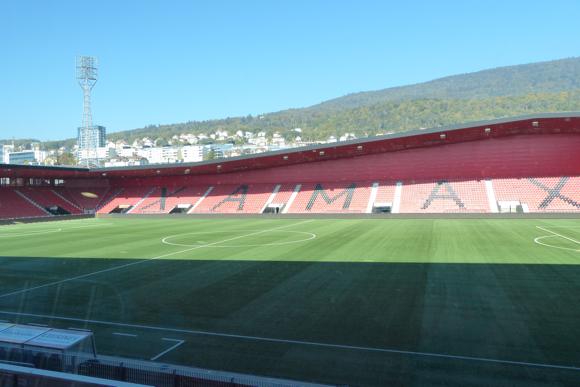


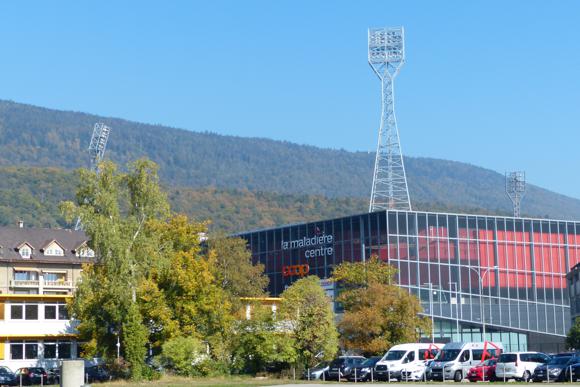
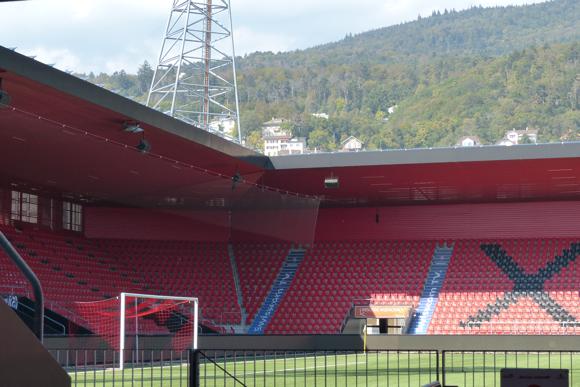

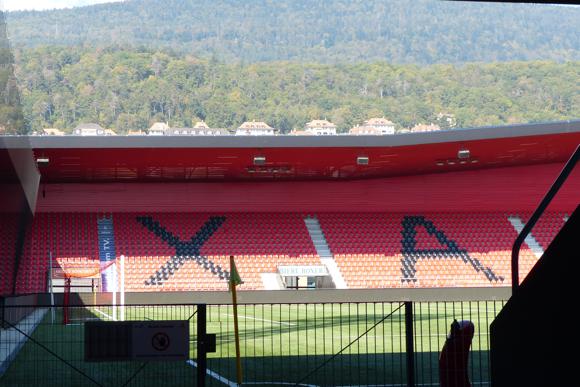
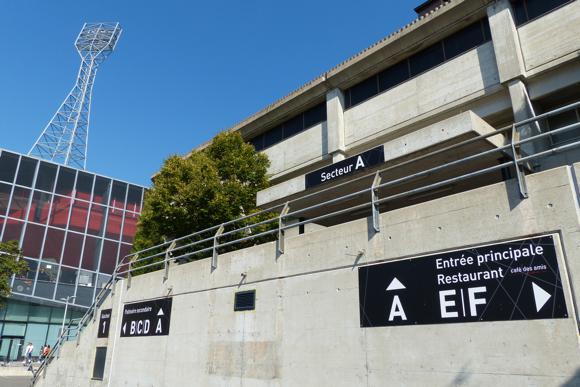

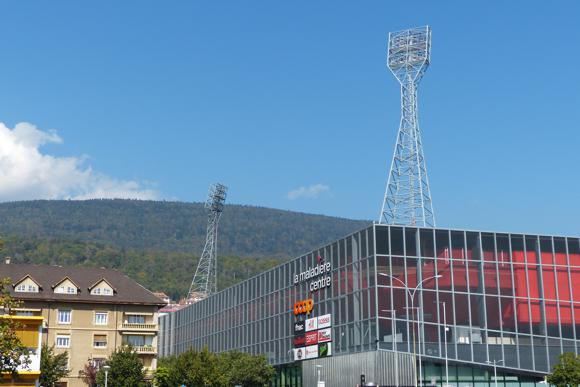
Centrepiece of a sport, leisure and retail complex since a rebuild completed in 2007, the Stade de la Maladière stands on the same site as its previous incarnation, opened in 1924.
Now holding 12,000, just less than half the crowd that crammed into the old ground for the visit of Real Madrid in 1986, la Maladière sits close to the waterfront, a short hop from the town centre and the train station above it.
Home to 54 shops, including one stocking Xamax merchandise, the stadium is prettier than its unpromisingly functional exterior suggests.

Done out in signature red and black, with ‘Xamax’ highlighted across the seating, the stadium has a low curving roof along each sideline, offering views of the hillsides beyond the residential housing also visible.
This is offset by the bright green of the artificial turf, the action watched by an average 3,500 spectators in 2017-18, and 5,500 for the autumn round of the Super League in 2018-19.
Stands are designed A-D, all numbered apart from section D4 in the home end, Tribune Est. Tribune (Ouest) B is the away end, for visiting supporters allocated B1-B3. The main stand, Tribune A Sud, is VIP-only.
getting there
Going to the stadium – tips and timings
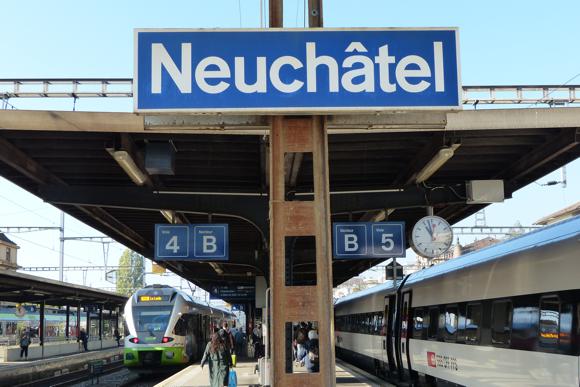
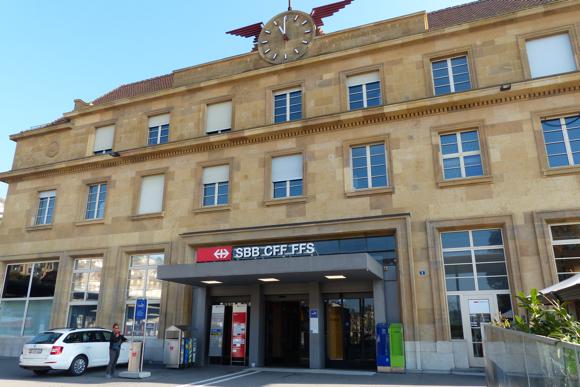
Even though public transport for match-ticket holders is free from 2hrs before kick-off and 2hrs after the final whistle, in practice the best way to get to the stadium from the town centre is to walk.
Bus 121 serving Maladière runs every 15mins Mon-Sat only, up to 8.20pm, and takes 4min to run the four stops from central place Pury.
From the train station, take the Fun’ambule funicular down the slope to the lower terminus at Université. The stadium is a 5-7min walk or one bus stop away.
getting in
Buying tickets – when, where, how and how much

Tickets are sold online for three or four home games in advance. The website is French-only but reasonably straightforward to work out – just hover the cursor over the place/s you want on the seating plan.
For all information, call +41 32 847 95 98 (Mon-Fri 8am-5pm) or use this contact form.
The ticket office opens 1hr before kick-off and sell-outs are rare.
The cheapest admission is SF25 in the home end, or anywhere in Tribune D and B, away fans able to pay on the day. A decent seat along sideline Tribune C Nord, or in the corners, is SF40-SF45. Seniors and students pay SF20 behind the goals and SF36 on the sideline, 6-16s are charged SF10/SF15. Under-6s go in free.
what to buy
Shirts, kits, merchandise and gifts


The Boutique Xamax (Mon-Wed, Fri 8.30am-7pm, Thur 8.30am-8pm, Sat 8.30am-6pm) is in the Maladière Centre mall surrounding the stadium.
First-team tops of red and black melting into each other differs from the classic stripes of 2017-18. Second kit is canary yellow.
Scarves, snapback hats and seat cushions for the stadium all carry the X logo for Xamax.
Where to Drink
Pre-match beers for fans and casual visitors

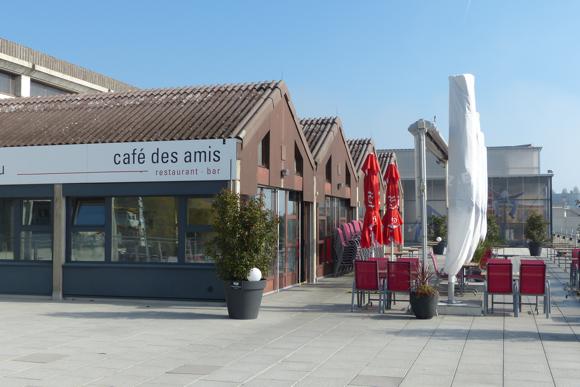



Between the main Tribune Sud and the waterfront, the Café des Amis is more restaurant than bar, but you’re welcome to find a terrace table, order a Swiss beer and enjoy the view of the lake. If you’re hungry, it’s around SF30 for a main course, SF16-SF18 for a flammekueche, the German-Swiss version of the pizza.
Right on the waterfront, Vio (closed Tue) calls itself a ‘Lifestyle Restaurant’, offering wok-based and grilled dishes – and that fabulous view. If you’re not in the mood for Thai soup, you can order a glass of draught Heineken at standard Swiss prices, possibly a bottle of craft ale La Torpille from BFM in Saignelégier, a half-litre of wine between you or a classic cocktail.
In the ground, kiosks serve Boxer beer from Yverdon on the shores of Lake Geneva.


